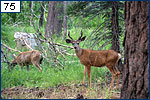
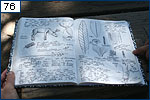
Diane Erwin: Paleobotany field trip to the Sierra Nevada
By UCMP museum scientist Diane Erwin, August 6, 2006
  |
|
|
|
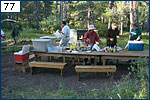 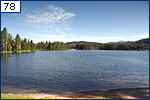 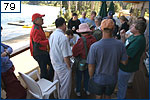 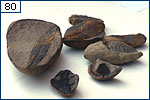 |
The next morning at Sagehen Creek, the group awoke to find a number of unintimidated mule deer grazing outside their cabins (photo 75, left). James McConnell caught two bucks with his camera while Greg Retallack sketched one in his field notebook (photo 76). In addition to deer, black bears and other wildlife are occasionally seen in or near the camp. But we couldn't spend much time watching the wildlife — the coffee was calling and we had another full day ahead so we got to work making and packing our lunches (photo 77, right).
We arrived at the Royal Gorge Ice Lakes Lodge in Soda Springs around 9:00 am for their breakfast buffet. We could see that it would be another beautiful day — looking north from the lodge (photo 78), Andesite Peak (cone-shaped peak) and Donner Summit (at the far right) were clearly visible on the horizon.
Before visiting the Soda Springs locality, Diane Erwin talked about the paleoflora (photo 79) while passing around specimens to show the group what to look for in the field (photo 80). The large concretion on the left and the one to its upper right show nice compressions of the Quercus nevadensis-type leaf. This is a common element in the paleoflora.
Stop 1: The Soda Springs locality
The Soda Springs site is unique. It is at an elevation of about 6990 feet (2130
meters) and the plants are encased in concretions similar in mode of preservation
to the Carboniferous Mazon Creek nodules from the Francis Creek Shale in Illinois. The
plant-bearing nodules were first discovered in 1993-94 by Edward Coutts and his
daughter, Vicky Black. At that time, Howard Schorn considered the age to be Eocene
based on a leaf similar to the Eocene species, Quercus nevadensis, which
is also found at the La Porte and Buckeye sites. However, Garside et al. (2005),
looking more closely at the geology, found that the plant-bearing beds rest on younger
Oligo-Miocene volcanic sediments (ignimbrites). We are not aware of an actual radioisotopic
date for the Soda Springs nodules, but they contain taxa that are only known in
this area from the Alta Formation andesites near Virginia City, Nevada (e.g.,
the conifer Fokienia, a member of the Cupressaceae which is still around
today — but it is found primarily in eastern China in mixed mesophytic
forest). In the Virginia City area, the Alta andesites have been dated at about 18-20
million years old. The Soda Springs specimens collected over the years are dispersed,
and they have never been examined as a unit, so any statement about the paleoflora at
this time, would not be significant. Some of the taxa present include a cf. magnolia,
willow, cf. Populus, two Fagaceae, and a few other taxa not yet identified. The
Soda Springs paleoflora is currently under investigation, as is the geology of the area.
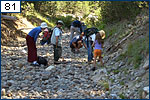 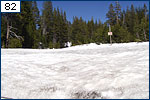 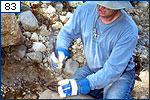 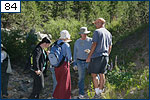 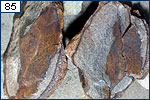 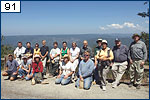 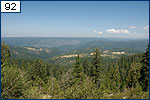 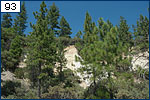 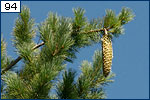 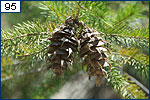 |
|
It was important to get a preview of the plant-bearing concretions since they are not especially easy to find. As you can see in photo 81 (left), the Soda Springs site is a creek bed full of rocks, pebbles, cobbles, nodules, and concretions, most of which do not contain plant remains.
But it could have been worse (at least for the trip leaders). Photo 82 shows what the Soda Springs site looked like back in May, just 2.5 months before the field trip. Like Webber Lake, Soda Springs is at an elevation of nearly 7000 feet. Fortunately for us, the snow melted away and the creek bed dried up.
People studying the Mazon Creek paleoflora found that placing the nodules in a freezer for several months, then splitting them after they had thawed a bit, made the rocks split much easier and more often along the plane on which the plant remains lay. This technique resulted in less fracturing and cleaner breaks, thereby exposing a more complete plant fossil specimen. But the members of our group weren't about to wait months to find out what may or may not be in the nodules they found. Paul Kester adopted the nodule-splitting "anvil technique" (photo 83) to satisfy his curiosity. He must have found something good because a crowd gathered to take a look (photo 84). If it had been frozen first, perhaps it may have have come out whole and with fewer cracks, but still, Paul's specimen was a nice one (photo 85).
|
|
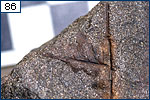 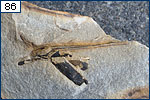 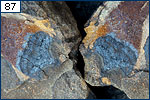 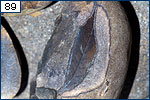 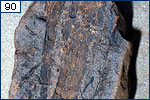 |
• A portion of a fern frond (photo 86, right) donated by Virginia Friedman, a
taxon previously unknown from the Soda Springs paleoflora.
• A possible legume pod (photo 87)? This one will require further study
to confirm that identification, but it too is a new record.
• Part and counterpart of a fossil fir (Abies) cone scale (photo
88). This also represents a new record.
• Although not new to the flora, a nice leaf of willow, Salix sp.
(photo 89), was collected.
• Stem parts (photo 90) — leaves are not the only plant remains found
in the Soda Springs nodules.
After spending the morning at Soda Springs, it was off to the Tahoe National Forest Omega Rest Area just off State Highway 20 for lunch and our group photo (photo 91, left). Here participants got a great panoramic view of the Alpha and Omega Diggings hydraulic gold mines along this stretch of the Yuba River (photo 92). The Yuba is one of the main paleochannels that comprised the ancestral river system which flowed down the western slope of the Sierra Nevada more than 50 million years ago. During California's Gold Rush the gold-bearing gravel and finer-grained deposits (i.e., Auriferous Gravels) of these old Tertiary channels were extracted using large water cannons (see photo 2, Day 1). These cannons shot streams of water five to seven inches in diameter, described to be as rigid as a rod of steel, against the river banks blasting away massive amounts of sediment that was processed with quicksilver (mercury) to remove the gold. For paleobotanists the "gold" is the beautifully preserved fossil plants we find in the shales associated with the Gravels. The 80-acre Alpha Diggings will be undergoing a "cleanup" operation by Tahoe National Forest (TNF) at a cost of about $332,000. They estimate that thousands of pounds of mercury, as well as other toxic chemicals like arsenic and lead, were used in the Alpha mining operation alone. This mine is just one of at least 200 abandoned mines known to the TNF for their toxic contamination. The cost of cleanup may be more than the amount of gold taken out.
Stop 2: The Buckeye locality
Like the La Porte locality on Day 1, the Buckeye site is located at an old
hydraulic mine, the Buckeye Diggings just outside of Nevada City.
In photo 93, you can see the exposures of the Ione Formation (Auriferous
Gravels). The Buckeye paleoflorule comes from the beds of the old paleochannel
in the lower left corner of the image. Here the elevation is about 3100 feet
and the mine is within the Sierran Montane (Lower Montane) vegetation zone
where ponderosa and sugar pines (Pinus lambertiana, photo 94) and
Douglas fir (Pseudotsuga menziesii, photo 95), are the dominant trees,
and manzanita (Arctostaphylos sp.), a common understory shrub.
The plants from the Buckeye Diggings site are currently being studied by colleagues at UCMP and the University of Arizona. This is the first study of these assemblages since MacGinitie's 1941 monograph some 65 years ago.
We'll continue with our exploration of the Buckeye locality in a minute, but first, here is some background (provided by Howard Schorn) on the Eocene landscape and the climate in which the Buckeye plants grew:
The Eocene Landscape — The Buckeye Diggings fossil plant assemblage is just a subset of what has become known as the regional Chalk Bluffs flora described by Harry MacGinitie in 1941. Like the Buckeye Diggings assemblage, the Chalk Bluff plants were deposited in floodplain sediments associated with the ancestral Yuba River drainage system that were later exposed through the hydraulic mining activities during California's Gold Rush. During the early middle Eocene, some 50-48 million years ago, the landscape of California was quite different than it is today. The Coast Ranges did not exist as such, and the Sierra Nevada was the west-facing slope, perhaps as high as it is today, of the Nevada plateau that would later extend and collapse and drop away from the Sierras to form the present Basin and Range. During the middle Eocene the present Central Valley of California was the site of a broad seaway.
During Earth's history, internal forces continually move the crustal layers sideways and up and down; this has occurred over and over throughout geologic time. When large areas of the ocean floor move up or down, global sea level rises or falls.
About 50 million years ago the waters of the "Central Valley" seaway began to regress. This drop in sea level caused the rivers flowing westward down the slopes of the ancestral Sierra Nevada to incise their valleys. Perhaps the largest drainage system of these ancestral rivers was the Eocene Yuba River. Later, probably about 49 million years ago, sea level began to rise. We may refer to this new landward transgression of the sea as the Domengine-Ione Seaway.
As sea level rose in the Domengine-Ione seaway it began to block up, or dam, the mouths of the rivers that flowed into this sea. This damming in turn caused the rivers to deposit the sediments they were carrying rather than move the material to the seaway. These gold-bearing sediments, deposited first in the deep river channel cut by the ancient Yuba River during the earlier low sea level stand, would become the deposits of the gold-rich "Blue Gravels." As sea level continued to rise, more sediment was deposited in the old channel until it was filled with the sediment that would become known as the gold-bearing "Red Gravels." Once the river channel was filled with sediment, the river spread out over the surrounding countryside and began to build a broad floodplain or bench above and on either side of the older, narrower channel. These higher, younger sediments would become the gold-bearing "Bench Gravels." Finally, as the Domengine-Ione seaway began to retreat, some erosion of the older sediments took place, and during this time, the youngest or "Upper Ione" sediments were deposited on top of the older or "Lower Ione" sediments. Excellent examples of these gold-bearing rocks are exposed in the You Bet and Red Dog, and numerous other hydraulic pits that dot the lower Sierras. David Lawler and Larry Garside have studied the paleochannels and provided maps of the drainage patterns of this ancestral Yuba River system.
At its maximum or highest extent, the Domengine-Ione seaway was about 900-1000 feet above present sea level. Waters of this seaway lapped up on the ancient shores of the Sierras from north of Oroville, southward to east of Marysville where the ancient Yuba River flowed into the sea, then southeast to places such as present day Lincoln, Folsom, Ione, and Valley Springs, and continuing southward at least to the San Joaquin River.
The upper age limits of the channel deposits is uncertain, but as the Domengine-Ione seaway began to retreat, this ended the deposition of the gold-bearing sediments in the ancient rivers such as the ancestral Yuba River.
The Ancient Climate — Both the nature of the sediments and the fossil plants indicate the early middle Eocene climate of ancient California resembled a subtropical to maybe tropical rainforest. Subtropical, as used here, refers to those places where the Mean Annual Temperature is between 59-68°F, and tropical is greater than 68°F.
Many physical characteristics of plants, such as leaf size and leaf margins, are directly related to environmental conditions such as temperature and precipitation. The leaves from plants living in a number of different present-day environments have been analyzed (largely by Jack A. Wolfe, 1979, 1995) to determine the set of leaf characters that defines each of these environments. These data drawn from living plants are then used to circumscribe "fossil environments" of temperature and precipitation.
The Eocene plant life of the Sierras stood in strong contrast to the present plants. We can think of the present vegetation as a mixed conifer forest. The common large trees are ponderosa pine, sugar pine and lesser numbers of knob-cone pines, willow, Fremont cottonwood, alders, and madrone. These plants live where the Mean Annual Temperature is about 54°F, the Mean Temperature of July is 70°F, the Mean Temperature of December is 40°F, and where the Mean Annual Precipitation is about 56 inches, where about 44 inches, or 80%, falls in the five winter months between November and March.
In contrast to the present flora and climate, the ancient Eocene forest had evergreen trees of magnolia, laurels, breadfruit, moonseed vines and other large forest plants that indicate the Mean Annual Temperature was about 62°F, the Mean Temperature of July was 72°F, the Mean Temperature of December was about 50°F, and the Mean Annual Precipitation occurred throughout the year and amounted to about 65 inches (1625 mm).
Conditions at lower elevations, such as along the ancient Domengine-Ione shore line, would have been even warmer; perhaps the Mean Annual Temperature would have been about 68°F, or borderline tropical as used here.
References
• MacGinitie, H.D. 1941. A middle Eocene flora from the central Sierra Nevada. Carnegie Institute of Washington Publication no. 534.
• Wolfe, J.A. 1979. Temperature parameters of humid to mesic forests of eastern Asia and relation to forests of other regions of the Northern Hemisphere and Australasia. U.S.G.S. Professional Paper 1106:1-37.
• Wolfe, J.A. 1995. Paleoclimatic estimates from Tertiary leaf assemblages. Annual Review of Earth and Planetary Sciences 23:119-142.
|
|
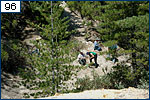 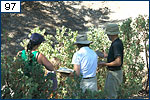 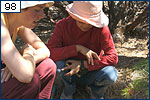 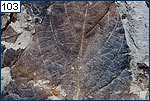 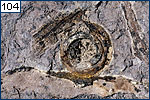 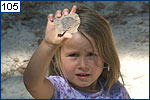 |
Trip co-leader Diane Erwin, here surrounded by manzanita (photo 97), consulted MacGinitie's Chalk Bluffs monograph to identify specimens found by group members.
In photo 98, co-leader Stephanie Stuart talks to Reiko Yamazaki about some of the specimens Reiko found at the site, which included pieces of petrified wood.
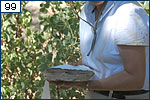 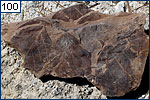 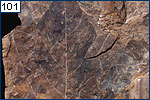 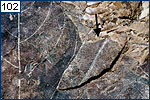 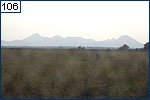 |
|
Identifying the leaves in the Eocene Chalk Bluffs paleoflora can be a challenge since many share similarities in their overall size, shape, and venation (photo 100). The distinguishing characteristics may be very subtle and need to be preserved in order to make conclusive identifications. These are characters of the leaf margin, apex, base, and petiole, as well as the finer venation. The best aid in identifying the affinities of the Buckeye plants is the presence of well-preserved cuticle that can be compared to modern taxa. The combination of venation pattern, leaf morphological characters, and epidermal features lead to the most accurate fossil leaf identifications.
For the most part, the fossil leaves at the Buckeye site are part of a leaf mat, so you often find a number of layers of leaves stacked on top of each other and oriented in every direction (photo 101). Because of this, one needs to look closely at the surface to make out what constitutes a single leaf. Here, there is a fragment of what MacGinitie recognized in the flora as an oleander-type leaf, Nerium hinoidea (indicated by the arrow in photo 102), overlying the larger Mallotus-type leaf fragment.
This small slab (photo 103, right), collected from the Ione Formation shales, shows the leaf litter of the subtropical/tropical forest that flourished in this region nearly 50 million years ago. When compared to the area's conifer-dominated flora today, one can easily see that there's been a marked change in climate. The large leaf here is a sycamore-type similar to the one MacGinitie identified as Platanus coloradensis Knowlton.
Lenny Kouwenberg found this interesting specimen that apears to be the remains of a tendril (photo 104). Tendrils are stem modifications found in many species of vines. MacGinitie did find leaves in the Chalk Bluffs paleoflora which he attributed to the grape family Vitaceae. Perhaps this is more evidence.
Future paleobotanist, Emma Thompson, shows off her prize leaf that she donated to the museum (photo 105).
The Buckeye site was our final locality of the trip. Returning to the Central Valley, we had this late afternoon view of Sutter Buttes from the van window (photo 106, left). Surrounded by the flat valley floor, it seems so out of place. Sutter Buttes is essentially a Pleistocene volcano. The Maidu Indians referred to Sutter Buttes as the "middle mountain" as it lies between the Coast Range and the Sierra Nevada.
Photo 82 by Diane Erwin; 75, 77-81, and 83-106 by Jim McConnell; 76 by Yuri Panchul.